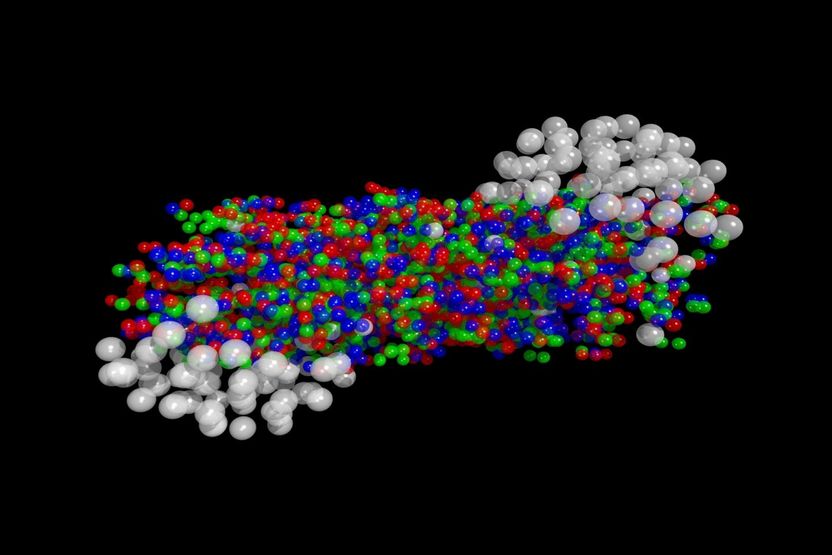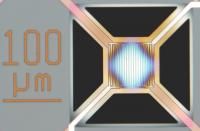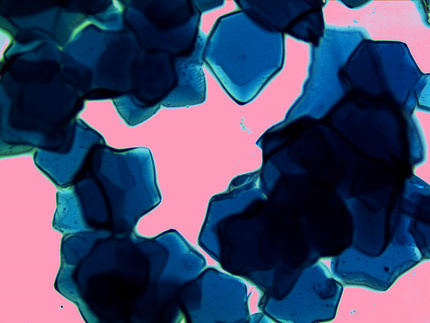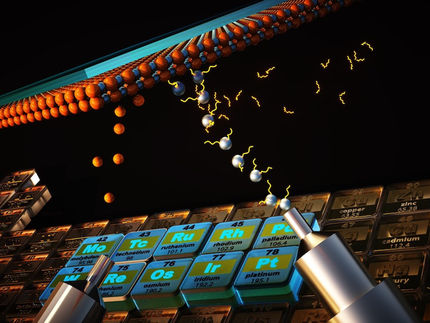Soluble Elements from a New Corner of the Periodic Table
The world of chemistry has a new first: a research group at the University of Würzburg has presented the first soluble and stable molecules containing an s-block atom in its elemental state. Normally these elements are highly reactive.

Beryllium in the center, flanked by two stabilizing cyclic ligands: another "world premiere" from Würzburg chemistry.
Julia Schuster
It is one of the more memorable experiments of high school chemistry lessons: when elemental sodium comes into contact with water it burns and explodes. Sodium simply isn't happy in its elemental form, making it highly reactive. This is more or less true for all of the other elements from the so-called "s-block" of the periodic table, to which sodium belongs.
A chemistry research group at the Julius-Maximilians-Universität (JMU) of Würzburg in Bavaria, Germany, has now, for the first time, tamed one of these "wild" s-block metals. The researchers constructed molecules that incorporate one atom of the alkaline earth metal beryllium in its elemental state. That the molecules do not immediately decompose at room temperature is thanks to stabilization by two cyclic ligands.
The breakthrough from the research team of Professor Holger Braunschweig is presented in the top-tier journal Nature Chemistry, thanks to the unexpectedly high stability of the molecules. These results from the JMU chemistry laboratories are expected to open a new era for the chemistry of the elements of this corner of the periodic table.
Promising candidates for challenging reactions
The incorporation of hydrogen and carbon monoxide into organic molecules is an example of one of the challenging chemical reactions carried out on huge scales in industry. Currently, these reactions are exclusively carried out with help from expensive heavy metals such as rhodium, palladium and platinum. For reasons of sustainability and cost, replacing these expensive catalysts with alternatives from the main group elements of the periodic table – many of which are abundant in the Earth's crust – would be a huge step forward.
This often means accessing the elemental states of these atoms in molecular systems. However, this is by no means trivial, as many of the potential candidate atoms ¬– sodium being an extreme example – are highly reactive in their elemental states. Recent success has been made with p-block elements such as silicon, tin and boron, while this new work is the first ever example with an s-block metal, beryllium.
Developing alternatives to toxic beryllium
"The only drawback of beryllium is its toxicity", states Dr. Merle Arrowsmith, Alexander von Humboldt postdoctoral fellow in the group of Holger Braunschweig. Even more interesting would be to extend this chemistry to magnesium or calcium, elements that are both abundant and biocompatible, making them ideal as potential catalysts for important chemical reactions.
Given their success in incorporating elementary beryllium into a stable molecule, the chances are good that this could also work with other s-block metals. "Our discovery is a first step in capturing other s-block metal atoms in their elemental state, which we hope will promote reactions that usually only proceed with expensive heavy metals," says Ph.D. student Julia Schuster, who synthesised the new molecules. The research group is currently developing similar methods for other s-block metals.
Original publication
Merle Arrowsmith, Holger Braunschweig, Mehmet Ali Celik, Theresa Dellermann, Rian D. Dewhurst, William C. Ewing, Kai Hammond, Thomas Kramer, Ivo Krummenacher, Jan Mies, Krzysztof Radacki, Julia K. Schuster; "Neutral zero-valent s-block complexes with strong multiple bonding“; Nature Chemistry; Advance Online Publication 6. Juni 2016.
Original publication
Merle Arrowsmith, Holger Braunschweig, Mehmet Ali Celik, Theresa Dellermann, Rian D. Dewhurst, William C. Ewing, Kai Hammond, Thomas Kramer, Ivo Krummenacher, Jan Mies, Krzysztof Radacki, Julia K. Schuster; "Neutral zero-valent s-block complexes with strong multiple bonding“; Nature Chemistry; Advance Online Publication 6. Juni 2016.
Organizations
Other news from the department science

Get the chemical industry in your inbox
By submitting this form you agree that LUMITOS AG will send you the newsletter(s) selected above by email. Your data will not be passed on to third parties. Your data will be stored and processed in accordance with our data protection regulations. LUMITOS may contact you by email for the purpose of advertising or market and opinion surveys. You can revoke your consent at any time without giving reasons to LUMITOS AG, Ernst-Augustin-Str. 2, 12489 Berlin, Germany or by e-mail at revoke@lumitos.com with effect for the future. In addition, each email contains a link to unsubscribe from the corresponding newsletter.
Most read news
More news from our other portals
Last viewed contents
Table_of_nuclides,_25-48
Steam_drum
Møller-Plesset_perturbation_theory
Twisting graphene into spirals - Researchers synthesize helical nanographene

The most exotic fluid has an unexpectedly low viscosity
Gramicidin

Sniffing out a better chemical sensor - Researchers at the NIST have created a new approach for “electronic noses”
Analytik Jena Delivers Instruments for Environmental Analysis to Poland
Corpuscularianism

Nanosphere at the quantum limit - Sensors could be immensely improved with nanospheres

Researchers discover carbon material with unique structure - "The material we synthesized is a hermaphrodite: for the first time, it forms a bridge between crystalline and amorphous, i.e. completely disordered, structures"





























































